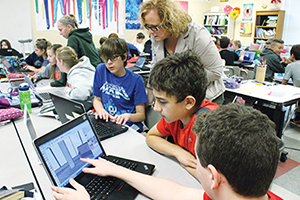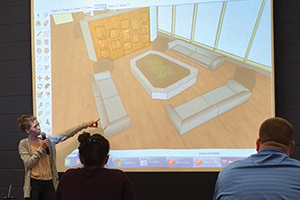Charging stations for personal electronics high on their recommendations
A new intensive care unit waiting room will need plenty of charging stations for electronic devices and a play area for little kids. That's the advice a group of middle schoolers gave construction planners at Mercy Health — Anderson Hospital in suburban Cincinnati. The executives were impressed and included the ideas in their plan for the waiting room. They went back the next year for more brainstorming from the young designers at Nagel Middle School, less than a mile from the hospital.

Julie Koenig, who teaches the design class at Nagel Middle School near Cincinnati, works with two students on ideas for the new atrium at Mercy Health - Anderson Hospital. They are Aden Malinowski, wearing the blue T-shirt, and Layth Alfwaress, wearing a red T-shirt.
In this, their fourth annual request, hospital officials asked students in the design class to help with the interior decoration of an atrium in a six-story, $74 million addition that is under construction. More than 30 seventh graders got to work on ways to make it appealing, tell the story of hospital foundresses the Sisters of Mercy, and lead visitors easily to their destinations.
During a presentation May 27 at the school, hospital and project leaders chose two student teams as co-winners among six finalists. The winning ideas include having a cubby system in the atrium with board games, reading material and other entertainment for visitors. The young designers also recommended including plenty of charging stations for phones and devices. "We will definitely include elements the students presented in their final designs," said Dr. Steve Feagins, Anderson Hospital's vice president of medical affairs. The winners will cut the ribbon when the addition is open this fall.

Feagins
Feagins said the notion of asking students to contribute ideas is a good way to promote the hospital in the community and give young people "some real-world experience." And they have good ideas, he said, like the extra charging stations outside the ICU.
"Honestly, we hadn't thought of that," Feagins said. "The fun for me is how the students always surprise us. They see they get taken seriously when they come up with a good idea, and they respond."
He said it also gives the students a chance to "learn more about that big sterile box, the hospital. Most of them had been born there, and they didn't know where it was."
Feagins said the hospital's design program with Nagel Middle School began five years ago in a general conversation with school administrators. They mentioned a recent student project with The Procter & Gamble Co., based in Cincinnati. Feagins, who was an engineer for Procter & Gamble before he enrolled in medical school, suggested the hospital give it a try.
In the first year, the hospital asked Nagel Middle School students to help design a new parking lot. It's not a subject for flights of fancy, but the kids went to work.
"We made it more of a math question about traffic volumes, the need for handicapped spots and room for emergency vehicles," Feagins said. "They worked hard on their presentations. A local TV station covered it. We had so much fun we decided to do it again."
That led to the ICU waiting room project. In the third year, students offered ideas for the hospital's new cafeteria. Once again, the students reminded the adults to have places for plugging in portable electronic devices.
Jodie McKinley, assistant to the principle at the 1,300-student middle school, said she likes how the project "lets the students see how their school work is directly related to the world they live in. They can take their learning beyond the classroom." McKinley gives the credit to Feagins who, she said, "is the brains behind this. He has continually presented opportunities to our students."

At a May 27 showcase, a Nagel Middle School student presents one of the winning ideas for a lobby seating area in a $74 million addition under construction at Mercy Health – Anderson Hospital. The design has cubby holes (represented as squares on the partition) to hold board games, books and magazines.
Anderson Hospital also assists the Forest Hills School District through its sports-medicine program, which provides personnel for the district athletic teams.
For the atrium project, the students toured the construction area and sat down with the architects and engineers to learn about the challenges and demands of the project. Some of the students proposed having a stone floor, and Feagins said the architects took time to explain why the need to move stretchers made a bumpy floor impractical.
Julie Koenig, who teaches the elective design class for seventh graders, said the students worked on ideas for color schemes, a display on the history of the Sisters of Mercy and a "donor wall" listing the financial contributors to the hospital addition.
"They are serious and creative," Koenig said of the students and their ideas.
Koenig and other teachers picked the design teams that presented their ideas to Feagins and the hospital staff. The hospital then chose the winners, whose ideas go to the architects and engineers to incorporate in their work.
All of the students who took part and their families will be invited to attend the ribbon-cutting for the new tower.
Feagins said he has been encouraged by the response from parents.
"I was on the sideline once for a game and a mother stopped to talk," he said. "It wasn't about sports. She wanted to tell me that her son had designed the parking lot."
Copyright © 2016 by the Catholic Health Association of the United States
For reprint permission, contact Betty Crosby or call (314) 253-3477.